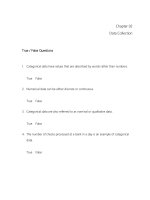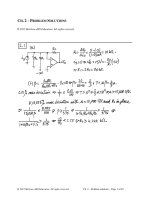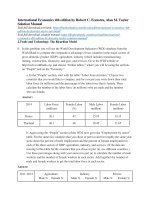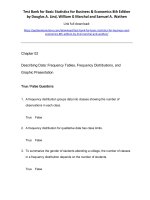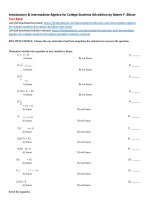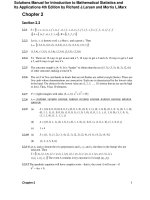Economics 4th edition by joseph e stiglitz and carl e walsh
Bạn đang xem bản rút gọn của tài liệu. Xem và tải ngay bản đầy đủ của tài liệu tại đây (12.01 MB, 971 trang )
∂
ECONOMICS
FOU RT H E D I T ION
Joseph E. Stiglitz
COLUMBIA UNIVERSITY
Carl E.Walsh
U N I V E R S I T Y O F C A L I F O R N I A , S A N TA C R U Z
∂
ECONOMICS
FOU RT H E D I T ION
B
W. W. N O RTO N & C O M PA N Y
N E W YO R K • L O N D O N
Copyright © 2006, 2002, 1997, 1993 by W. W. Norton & Company, Inc.
W. W. Norton & Company has been independent since
its founding in 1923, when William Warder Norton and
All rights reserved
Mary D. Herter Norton first published lectures
Printed in the United States of America
delivered at the People’s Institute, the adult education
B
division of New York City’s Cooper Union. The Nortons
Manufacturing by RR Donnelley
soon expanded their program beyond the Institute,
Book design by Rubina Yeh
publishing books by celebrated academics from
Editor: Jack Repcheck
America and abroad. By mid-century, the two major
Director of Manufacturing—College: Roy Tedoff
pillars of Norton’s publishing program—trade books
Project Editor: Lory A. Frenkel
and college texts—were firmly established. In the
Manuscript Editor: Alice Falk
1950s, the Norton family transferred control of the
Editorial Assistants: Sarah Solomon, Mik Awake
company to its employees, and today—with a staff of
Photo Researcher: Kelly Mitchell
four hundred and a comparable number of trade,
college, and professional titles published each year—
W. W. Norton & Company stands as the largest and
Library of Congress Cataloging-in Publication Data
oldest publishing house owned wholly by its
Stiglitz, Joseph E.
employees.
Economics / Joseph E. Stiglitz, Carl E. Walsh.—4th ed.
p. cm.
Includes index.
ISBN 0-393-92622-2
1. Economics. I. Walsh, Carl E. II. Title
HB171.5.S884
2005
330—dc22
ISBN 0-393-11644-1 (ebook)
W. W. Norton & Company, Inc., 500 Fifth Avenue, New York, N. Y. 10110
www.wwnorton.com
W. W. Norton & Company Ltd., Castle House, 75/76 Wells Street, London W1T 3QT
1 2 3 4 5 6 7 8 9 0
2005055518
ABOUT THE AUTHORS
Joseph E. Stiglitz is professor of economics, business, and international and
public affairs at Columbia University. Before joining the Columbia faculty, he held
appointments at Yale, Oxford, Princeton, and Stanford. Internationally recognized
as one of the leading economists of his generation, Professor Stiglitz has made important contributions to virtually all of the major subfields of economics, in particular
the economics of information, one of the key topics highlighted in this text. He was
a co-recipient of the Nobel Prize in Economic Science in 2001, and earlier in his
career received the American Economic Association’s John Bates Clark Medal,
which is given every two years to the most outstanding economist under the age of
forty. Professor Stiglitz is the author and editor of hundreds of scholarly articles
and books, including the best-selling undergraduate textbook Economics of the Public
Sector (Norton) and, with Anthony Atkinson, the classic graduate textbook Lectures
in Public Economics. He is the author of two influential popular books as well:
Globalization and Its Discontents and The Roaring Nineties. In addition, he was the
founding editor of the Journal of Economic Perspectives. Professor Stiglitz has also
played a prominent role at the highest levels of economic policy making. He was a
member and chairman of President Clinton’s Council of Economic Advisers and
later served as Senior Vice President and Chief Economist of the World Bank.
Carl E. Walsh is professor of economics at the University of California, Santa
Cruz, where he teaches principles of economics. He previously held faculty appointments at Princeton and the University of Auckland, New Zealand, and has been a visiting professor at Stanford. He is widely known for his research in monetary economics
and is the author of a leading graduate text, Monetary Theory and Policy (MIT Press).
Before joining the Santa Cruz faculty, Professor Walsh was senior economist at the
Federal Reserve Bank of San Francisco, where he continues to serve as a visiting
scholar. He has also been a visiting scholar at the Federal Reserve Banks of Kansas
City, Philadelphia, and at the Board of Governors. He has taught courses in monetary economics to the research department and staff economists at the central banks
of Hong Kong, Norway, Portugal, Spain, and the United Kingdom, and at the
International Monetary Fund. He is a past member of the board of editors of the
American Economic Review and is currently an associate editor of the Journal of
Money, Credit, and Banking and the Journal of Economics and Business. He is also on
the editorial board of the Journal of Macroeconomics.
∂v
This page intentionally left blank
CONTENTS IN BRIEF
PART 1
INTRODUCTION
1
Chapter 1
Chapter 2
Modern Economics • 3
Thinking Like an Economist • 25
PART 2
PERFECT MARKETS
Chapter 3
Chapter 4
Chapter 5
Chapter 6
Chapter 7
Chapter 8
Chapter 9
Chapter 10
Demand, Supply, and Price • 53
Using Demand and Supply • 77
The Consumption Decision • 101
The Firm’s Costs • 131
The Competitive Firm • 155
Labor Markets • 175
Capital Markets • 191
The Efficiency of Competitive Markets • 215
PART 3
IMPERFECT MARKETS
Chapter 11
Chapter 12
Chapter 13
Chapter 14
Chapter 15
Chapter 16
Introduction to Imperfect Markets • 239
Monopoly, Monopolistic Competition, and Oligopoly • 261
Government Policies Toward Competition • 289
Strategic Behavior • 311
Imperfect Information in the Product Market • 333
Imperfections in the Labor Market • 355
PART 4
ISSUES IN PUBLIC POLICY
Chapter 17
Chapter 18
Chapter 19
Chapter 20
The Public Sector • 375
Environmental Economics • 405
International Trade and Trade Policy • 423
Technological Change • 453
PART 5
INTRODUCTION TO MACROECONOMICS
Chapter 21
Chapter 22
Chapter 23
Macroeconomics and the Economic Perspective • 473
Measuring Output and Unemployment • 485
The Cost of Living and Inflation • 509
51
237
373
471
∂ vii
PART 6
FULL-EMPLOYMENT MACROECONOMICS
Chapter 24
Chapter 25
Chapter 26
Chapter 27
Chapter 28
The Full-Employment Model • 525
Government Finance at Full Employment • 547
The Open Economy at Full Employment • 567
Growth and Productivity • 585
Money, the Price Level, and the Federal Reserve • 605
PART 7
MACROECONOMIC FLUCTUATIONS
Chapter 29
Chapter 30
Chapter 31
Chapter 32
Chapter 33
Introduction to Macroeconomic Fluctuations • 637
Aggregate Expenditures and Income • 661
Aggregate Demand and Inflation • 689
The Federal Reserve and Interest Rates • 715
The Role of Macroeconomic Policy • 727
PART 8
THE GLOBAL ECONOMY
Chapter 34
Chapter 35
Chapter 36
The International Financial System • 757
Policy in the Open Economy • 779
Development and Transition • 793
PART 9
FURTHER TOPICS IN MACROECONOMICS
Chapter 37
Chapter 38
Chapter 39
Inflation and Unemployment • 819
Controversies in Macroeconomic Policy • 837
A Student’s Guide to Investing • 865
viii ∂
523
635
755
817
CONTENTS
PREFACE
XXXV
PART 1
INTRODUCTION 1
CHAPTER 1
MODERN ECONOMICS
3
INTERNET CONNECTION: Tracking the Digital
Economy 6
What Is Economics?
Trade-offs 7
Incentives 8
6
THINKING LIKE AN ECONOMIST: Incentives and
the Price of AOL
Exchange 10
9
INTERNET CONNECTION: Auction Sites
11
Information 13
Distribution 14
The Three Major Markets 15
Keeping Track of Tricky Terms 16
Microeconomics and Macroeconomics: The Two
Branches of Economics 17
The Science of Economics 18
Discovering and Interpreting Relationships 18
Causation and Correlation 19
Why Economists Disagree 19
REVIEW AND PRACTICE
21
CONTENTS
∂ ix
CHAPTER 2
THINKING LIKE AN ECONOMIST
25
The Basic Competitive Model 25
Rational Consumers and Profit-Maximizing Firms 26
Competitive Markets 27
e-INSIGHT: Markets, Exchange, and e-Commerce 27
Efficiency and Distribution in the Basic Competitive
Model 28
The Basic Competitive Model as a Benchmark 28
Incentives and Information: Prices, Property Rights, and
Profits 29
Incentives Versus Equality 31
When Property Rights Fail 31
Alternatives to the Price System 32
Opportunity Sets and Trade-Offs 34
Budget and Time Constraints 34
The Production Possibilities Curve 35
Costs 37
Opportunity Costs 38
THINKING LIKE AN ECONOMIST: Trade-Offs 39
INTERNET CONNECTION: Internet Resources for
Economists 40
CASE IN POINT: The Opportunity Cost of Attending
College 40
Sunk Costs 42
Marginal Costs 43
INTERNET CONNECTION: The Economists’ Voice
43
REVIEW AND PRACTICE
APPENDIX: Reading Graphs
Slope 48
Interpreting Curves
45
47
49
PART 2
PERFECT MARKETS 51
CHAPTER 3
DEMAND, SUPPLY, AND PRICE
The Role of Prices 53
Demand 54
The Individual Demand Curve 54
The Market Demand Curve 55
Shifts in Demand Curves 57
x ∂ CONTENTS
53
Sources of Shifts in Demand Curves 57
CASE IN POINT: Gasoline Prices and the Demand for
SUVs 59
Shifts in a Demand Curve Versus Movements along a
Demand Curve 60
FUNDAMENTALS OF DEMAND, SUPPLY, AND
PRICE 1: Demand Declines as Price Rises
Supply
61
61
e-INSIGHT: The Demand for Computers and
Information Technology 62
Market Supply 64
Shifts in Supply Curves 65
Sources of Shifts in Supply Curves 65
Shifts in a Supply Curve Versus Movements along a
Supply Curve 67
FUNDAMENTALS OF DEMAND, SUPPLY, AND
PRICE 2: Supply Increases as Price Rises
Law of Supply and Demand 67
Using Demand and Supply Curves 69
Consensus on the Determination of Prices
67
70
FUNDAMENTALS OF DEMAND, SUPPLY, AND
PRICE 3: The Market Clears at the Equilibrium
Price 71
Price, Value, and Cost 70
INTERNET CONNECTION: The Demand and Supply
in the Oil Market 71
REVIEW AND PRACTICE
CHAPTER 4
72
USING DEMAND AND SUPPLY
77
The Price Elasticity of Demand 77
Price Elasticity and Revenues 79
The Determinants of the Elasticity of Demand 80
The Price Elasticity of Supply 82
INTERNATIONAL PERSPECTIVE: Comparing
Reactions to the Oil Price Shock of 2000 83
Using Demand and Supply Elasticities 85
Shortages and Surpluses 88
Interfering with the Law of Supply and Demand 90
THINKING LIKE AN ECONOMIST: Incentives and
the Window Tax 90
Price Ceilings 91
CASE IN POINT: Rent Control in New York City 93
CONTENTS
∂ xi
Price Floors
93
INTERNET CONNECTION: Flawed Deregulation
Alternative Solutions
REVIEW AND PRACTICE
96
APPENDIX: Elasticity and Slope
CHAPTER 5
94
94
98
THE CONSUMPTION DECISION
101
The Basic Problem of Consumer Choice 101
The Budget Constraint 102
Choosing a Point on the Budget Constraint: Individual
Preferences 104
What Happens to Consumption When Income Changes?
105
CASE IN POINT: The Fate of the BTU Tax 107
INTERNET CONNECTION: What We Consume 109
A Closer Look at the Demand Curve 109
Deriving Demand Curves 110
The Importance of Distinguishing Between Income and
Substitution Effects 111
THINKING LIKE AN ECONOMIST: Incentives,
Income Effects, and Substitution Effects 112
Utility and the Description of Preferences 113
Consumer Surplus 117
Looking Beyond the Basic Model 118
How Well Do the Underlying Assumptions Match Reality?
118
Behavioral Economics 119
REVIEW AND PRACTICE
122
APPENDIX: Indifference Curves and the Consumption
Decision 124
Using Indifference Curves to Illustrate Consumer Choices
124
Indifference Curves and Marginal Rates of Substitution
126
Using Indifference Curves to Illustrate Choices 127
Using Indifference Curves to Derive Demand Curves 128
Substitution and Income Effects 128
CHAPTER 6
THE FIRM’S COSTS
131
Profits, Costs, and Factors of Production 132
Production with One Variable Input 132
Types of Costs and Cost Curves 135
xii ∂ CONTENTS
Short-Run and Long-Run Cost Curves 141
Short-Run Cost Curves 142
Long-Run Cost Curves 142
INTERNET CONNECTION: Economic Definitions
146
Production with Many Factors 146
Cost Minimization 147
The Principle of Substitution 147
CASE IN POINT: The Principle of Substitution and
Global Warming 148
Economies of Scope 150
REVIEW AND PRACTICE
CHAPTER 7
151
THE COMPETITIVE FIRM
155
Revenue 155
Costs 156
INTERNET CONNECTION: Firms’ Profit-and-Loss
Statements 157
Basic Conditions of Competitive Supply 158
Entry, Exit, and Market Supply 160
Sunk Costs and Exit 161
The Firm’s Supply Curve 162
The Market Supply Curve 163
Long-Run Versus Short-Run Supply 164
e-INSIGHT: The 2001 Recession: Cutbacks Versus
Shutdowns 165
Accounting Profits and Economic Profits 166
Opportunity Costs 166
Economic Rent 168
CASE IN POINT: Entering the Painting Business and
Opportunity Costs 169
The Theory of the Competitive Firm 171
REVIEW AND PRACTICE
CHAPTER 8
172
LABOR MARKETS
175
The Labor Supply Decision
175
INTERNET CONNECTION: Labor Force Data
176
176
The Choice Between Leisure and Consumption
Labor Force Participation 179
THINKING LIKE AN ECONOMIST: Trade-Offs
Firms and the Demand for Labor 181
Factor Demand 182
179
CONTENTS
∂ xiii
From the Firm’s Factor Demand to the Market’s Factor
Demand 184
Labor Supply, Demand, and the Equilibrium Wage 184
REVIEW AND PRACTICE
186
APPENDIX: Indifference Curves and the Labor Supply
Decision 188
Deciding Whether to Work
CHAPTER 9
CAPITAL MARKETS
188
191
Supply in the Capital Market 191
The Household Decision to Save 192
THINKING LIKE AN ECONOMIST: Wealth
Distribution and Interest Rates
197
INTERNET CONNECTION: Household Saving
198
CASE IN POINT: Why is the U.S. Saving Rate So Low?
198
Demand in the Capital Market 200
A Behavioral Perspective on Saving 202
Education and Human Capital 203
e-INSIGHT: Financing the New Economy 205
Education and Economic Trade-Offs 206
The Basic Competitive Model 206
REVIEW AND PRACTICE
207
APPENDIX A: Indifference Curves and the Saving
Decision 209
Deciding How Much to Save 209
Changing the Interest Rate 210
APPENDIX B: Calculating Present Discounted Value
211
CHAPTER 10 THE EFFICIENCY OF COMPETITIVE
MARKETS
215
Competitive Markets and Economic Efficiency
Consumer and Producer Surplus 217
216
FUNDAMENTALS OF COMPETITIVE MARKETS 1:
Households and Firms are Price Takers
218
FUNDAMENTALS OF COMPETITIVE MARKETS 2:
The Equilibrium Price Maximizes Consumer Plus
Producer Surplus 219
INTERNET CONNECTION: Digital Economist 219
Taxes and Efficiency 220
Efficiency 221
Pareto Efficiency 222
xiv ∂ CONTENTS
Conditions for the Pareto Efficiency of the Market
Economy 222
THINKING LIKE AN ECONOMIST: Exchange and
Distribution 224
Competitive Markets and Pareto Efficiency 225
FUNDAMENTALS OF COMPETITIVE MARKETS 3:
The Competitive Market Economy is Pareto
Efficient 225
Competitive Markets and Income Distribution 225
General Equilibrium Analysis 227
The Basic Competitive Equilibrium Model 227
THINKING LIKE AN ECONOMIST: Indirect TradeOffs and Air Safety for Children 228
CASE IN POINT: The Labor Market and the Widening
Wage Gap 230
CASE IN POINT: The Minimum Wage and General
Equilibrium 231
General Equilibrium Over Time 232
When Partial Equilibrium Analysis Will Do 234
Looking Beyond the Basic Model 234
REVIEW AND PRACTICE
PART 3
235
IMPERFECT MARKETS 237
CHAPTER 11 INTRODUCTION TO IMPERFECT
MARKETS
239
Extending the Basic Competitive Model
240
FUNDAMENTALS OF IMPERFECT MARKETS 1:
Imperfect Markets Lead to Market Failures 242
Imperfect Competition and Market Structure 242
Price and Quantity with Imperfect Competition 244
Government Policies 245
INTERNET CONNECTION: The Federal Trade
Commission 245
INTERNATIONAL PERSPECTIVE: Trade and
Competition 246
FUNDAMENTALS OF IMPERFECT MARKETS 2:
Imperfect Competition 246
Imperfect Information 247
The Information Problem 247
How Big a Problem? 247
CONTENTS
∂ xv
How Prices Convey Information 248
Markets for Information 249
e-INSIGHT: Information, Competition, and the Internet
249
Government Policies 250
FUNDAMENTALS OF IMPERFECT MARKETS 3:
Imperfect Information 251
Externalities 252
Government Policies Toward Externalities 252
THINKING LIKE AN ECONOMIST: Incentives and
the Environment 253
FUNDAMENTALS OF IMPERFECT MARKETS 4:
Externalities
Public Goods 254
254
FUNDAMENTALS OF IMPERFECT MARKETS 5:
Public Goods 255
Looking Ahead 256
REVIEW AND PRACTICE
257
CHAPTER 12 MONOPOLY, MONOPOLISTIC
COMPETITION, AND OLIGOPOLY
261
Monopoly Output 261
An Example: The ABC-ment Company 264
Monopoly Profits 265
Price Discrimination 266
Economies of Scale and Natural Monopolies 267
INTERNATIONAL PERSPECTIVE: South Africa,
AIDS, and Price Discrimination 268
Assessing the Degree of Competition 270
Number of Firms in the Industry 270
Product Differentiation 271
e-INSIGHT: Network Externalities, the New Economy,
and Monopoly Power 272
Equilibrium with Monopolistic Competition 273
Oligopolies 274
Collusion 275
Restrictive Practices 279
Entry Deterrence 281
INTERNET CONNECTION: Keeping Track of
Oligopolies 281
xvi ∂ CONTENTS
THINKING LIKE AN ECONOMIST: Trade-Offs,
American Airlines, and Predation 283
The Importance of Imperfections in Competition
REVIEW AND PRACTICE
284
285
CHAPTER 13 GOVERNMENT POLICIES TOWARD
COMPETITION
289
The Drawbacks of Monopolies and Limited Competition
289
Restricted Output 289
Managerial Slack 291
Reduced Research and Development 291
Rent Seeking 292
Further Drawbacks of Limited Competition 292
e-INSIGHT: Using the Internet to Enhance Price
Discrimination 293
Policies Toward Natural Monopolies 293
Public Ownership 294
Regulation 295
Encouraging Competition 296
INTERNATIONAL PERSPECTIVE: The Darker Side of
Privatization 296
CASE IN POINT: California Electricity Deregulation
298
Antitrust Policies 299
Limiting Market Domination 300
Defining Markets 301
INTERNET CONNECTION: U.S. Department of
Justice and Antitrust Laws 301
THINKING LIKE AN ECONOMIST: Incentives and
the Remedy to the Microsoft Monopoly Problem
302
Curbing Restrictive Practices 304
Enforcing the Antitrust Laws 305
CASE IN POINT: Coke and Pepsi Play Merger 306
REVIEW AND PRACTICE
308
CHAPTER 14 STRATEGIC BEHAVIOR
Review of the Prisoner’s Dilemma
Dominant Strategies 313
311
312
CONTENTS
∂ xvii
Nash Equilibrium 313
Strategic Behavior in More General Games 316
Games With Only One Dominant Strategy 316
INTERNATIONAL PERSPECTIVE: Beggar-ThyNeighbor Tariff Policies 317
Games Without Dominant Strategies 318
INTERNET CONNECTION: The Zero-Sum Game
Solver 319
Repeated Games 320
Reputations 321
Tit for Tat 321
INTERNET CONNECTION: The Prisoner’s Dilemma
321
Institutions 322
CASE IN POINT: Banking Panics 322
Sequential Moves 324
THINKING LIKE AN ECONOMIST: Information and
Thinking Strategically 326
Time Inconsistency 326
Commitment 327
REVIEW AND PRACTICE
329
CHAPTER 15 IMPERFECT INFORMATION IN THE
PRODUCT MARKET
333
The Market for Lemons and Adverse Selection 333
Signaling 335
Judging Quality by Price 336
The Incentive Problem 337
Market Solutions 337
Contract Solutions 338
Reputation Solutions 339
The Market for Health Insurance 340
CASE IN POINT: Buying Health Insurance 341
The Search Problem 342
THINKING LIKE AN ECONOMIST: Incentive and
Information Problems in the Housing Market
343
e-INSIGHT: Information Technology and Middlemen
344
INTERNET CONNECTION: Job Search 345
Search and Imperfect Competition 345
Search and the Labor Market 346
xviii ∂ CONTENTS
Search and Information Intermediaries 346
Advertising 347
Advertising and Competition 348
Advertising and Profits 348
The Importance of Imperfect Information 350
REVIEW AND PRACTICE
351
CHAPTER 16 IMPERFECTIONS IN
THE LABOR MARKET
355
Labor Unions 355
A Brief History 356
INTERNET CONNECTION: Unions on the Internet
358
Economic Effects 359
Limits on Union Power 360
Wage Differentials 362
Discrimination 363
Motivating Workers 364
Piece Rates and Incentives 365
Efficiency Wages 366
CASE IN POINT: Minimum Wages 367
Other Incentives 368
Compensating Workers 368
e-INSIGHT: Labor Markets and the Internet
REVIEW AND PRACTICE
PART 4
369
371
ISSUES IN PUBLIC POLICY
373
CHAPTER 17 THE PUBLIC SECTOR
375
Why Does the Government Intervene in the Economy?
377
INTERNATIONAL PERSPECTIVE: The Size of
Government in Different Countries 377
Equity-Efficiency Trade-Offs 380
e-INSIGHT: The New Economy and Inequality 381
The U.S. Tax System in Practice 381
CONTENTS
∂ xix
Characteristics of a Good Tax System 382
The Scope of the U.S. Tax System 383
Grading the U.S. Tax System 383
Transfers 386
Welfare 387
Housing 388
Social Insurance 389
Designing Government Programs 390
Government Failures 391
Incentives and Constraints 392
Budgeting and Spending Procedures 393
Imperfections of Information 393
Collective Decision Making 394
Current and Recent Controversies in the Economics of
the Public Sector 395
Dealing With the Deficit 395
Social Security 396
Health Care 398
INTERNET CONNECTION: Policy Analysis 400
REVIEW AND PRACTICE
401
CHAPTER 18 ENVIRONMENTAL ECONOMICS
405
Negative Externalities and Oversupply 405
Policy Responses to Problems in the Environment 407
Property Rights Responses 407
INTERNATIONAL PERSPECTIVE: Global Warming
408
THINKING LIKE AN ECONOMIST: Environmental
and Economic Trade-Offs 410
Regulation 410
Taxes and Subsidies 412
The Marketable Permit Response 413
CASE IN POINT: Reducing Acid Rain 414
Weighing the Alternative Approaches 415
Natural Resources 416
INTERNET CONNECTION: The National Center for
Environmental Economics 416
e-INSIGHT: Information and the Environment 418
Merit Goods and the Environment 418
REVIEW AND PRACTICE
xx ∂ CONTENTS
419
CHAPTER 19 INTERNATIONAL TRADE AND TRADE
POLICY
423
Trade Between Countries 423
Interdependence in the Product Market 424
Interdependence in the Labor Market 424
Interdependence in the Capital Market 425
Multilateral Trade 425
Comparative Advantage 426
INTERNET CONNECTION: David Ricardo 427
Production Possibilities Curves and Comparative
Advantage 427
Comparative Advantage and Specialization 428
e-INSIGHT: The United States’ Comparative Advantage
in the Internet Age 429
What Determines Comparative Advantage? 430
The Perceived Costs of International Interdependence
432
THINKING LIKE AN ECONOMIST: Exchange and
the Globalization Controversy 432
Trade Policies 434
Commercial Policy 434
Tariffs 435
Quotas 436
Voluntary Export Restraints 436
Other Nontariff Barriers 437
“Fair Trade” Laws 437
INTERNATIONAL PERSPECTIVE: Surrogate
Countries and Canadian Golf Carts 438
Political and Economic Rationale for Protection 439
Displaced Firms and Workers 440
Beggar-Thy-Neighbor Policies 441
Wages in Affected Sectors 442
Increased Competition 442
THINKING LIKE AN ECONOMIST: Distribution and
Trade Liberalization 443
The Infant Industry Argument 443
e-INSIGHT: Trade Liberalization in Information
Technology and Financial Services 444
Strategic Trade Theory 445
International Cooperation 445
GATT and the WTO 445
CONTENTS
∂ xxi
The Growing Protest Against the WTO 446
CASE IN POINT: The Banana War 447
Regional Trading Blocs 448
INTERNET CONNECTION: The World Trade
Organization 449
REVIEW AND PRACTICE
450
CHAPTER 20 TECHNOLOGICAL CHANGE
453
Links Between Technological Change and Imperfect
Competition 454
e-INSIGHT: The New Economy and Innovation 455
Patents and the Production of Ideas 455
THINKING LIKE AN ECONOMIST: Intellectual
Property Rights and Distribution 456
The Trade-Off Between Short-term Efficiency and
Innovation 457
CASE IN POINT: Eli Whitney and the Cotton Gin 460
R & D as a Fixed Cost 460
Learning by Doing 461
Access to Capital Markets 462
Schumpeterian Competition 463
Basic Research as a Public Good 464
Government Promotion of Technological Progress 465
Subsidies 465
Protection 466
Relaxing Antitrust Policies 466
INTERNET CONNECTION: Competitiveness 468
Technological Change and Economic Growth 468
REVIEW AND PRACTICE
PART 5
469
INTRODUCTION TO
MACROECONOMICS 471
CHAPTER 21 MACROECONOMICS AND THE
ECONOMIC PERSPECTIVE
473
The Commitment to Full Employment and Growth
Getting the Country Moving Again 477
Stagflation 477
The Conquest of Inflation 478
xxii ∂ CONTENTS
474
Government Deficits and Trade Deficits 479
Getting the Economy Moving (Again) 479
New Challenges 480
The Three Key Goals of Macroeconomic Performance
A Look Ahead 482
REVIEW AND PRACTICE
481
483
CHAPTER 22 MEASURING OUTPUT AND
UNEMPLOYMENT
485
Measuring Output and Growth 485
Gross Domestic Product 486
Measuring GDP: The Value of Output 489
INTERNET CONNECTION: The Bureau of Economic
Analysis 489
CASE IN POINT: Is Software a Final Good or an
Intermediate Good? 491
Potential GDP 494
INTERNATIONAL PERSPECTIVE: What Gets
Measured in the GDP? 495
Problems in Measuring Output 496
Measuring the Standard of Living 497
A Green GDP 497
Unemployment 498
Unemployment Statistics 499
Forms of Unemployment 500
Output Gaps and the Natural Rate of Unemployment 503
Flows and Stocks 505
REVIEW AND PRACTICE
506
CHAPTER 23 THE COST OF LIVING
AND INFLATION
509
The Costs of Inflation 509
Who Suffers from Inflation 510
The Economy 511
The Costs of Deflation 512
CASE IN POINT: Hyperinflation in Germany in the
1920s 512
Measuring Inflation 514
INTERNET CONNECTION: Improving Our Measure
of the CPI 516
CASE IN POINT: The Price Index Makes a Difference
516
CONTENTS
∂ xxiii



